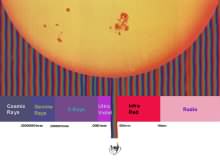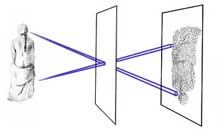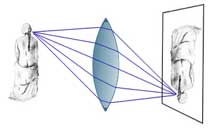The Science of Photography - Forming the Image
|
Chemical Image Processing | Digital Image Processing Subject Lighting | Halftone Reproduction | Mechanical Printing |
| The Nature of Light |
It may seem obvious but without light we wouldn't be able to see ! However, perhaps a little less obviously, it is the properties of light that determine how we view an object.
Physicists classify visible light as part of the electromagnetic spectrum. The non visible parts of the spectrum include radio waves, radar and x-rays. It may seem strange to think of light waves being similar to radio waves, however the only difference between them is their wavelength.
 |
| The Image and the Eye |
The word Photography is derived from "drawing with light". It is the action of light being reflected back off a subject and then being processed by our eyes and brain that provides us with our sense of sight.
When light is reflected from a subject it is focused by the lens in our eye and the resulting image is captured by the light sensitive retina. The image is then transmitted to our brain by way of the optic nerve.
Move the mouse over the links below to see the how the eye changes the focal length of the lens by making it thicker or thinner.
|
 |
Light intensity is controlled by the iris, focusing is achieved by the muscles stretching and compressing the flexible lens and the millions of cells in the retina chemically respond to light. Your brain will interpret the messages it receives from the optic nerve to give you your sense of sight.
| Focusing Light |
Every point on a subject is reflecting light, this jumble of light needs to be controlled in order to form an image.
The ‘pinhole camera’ restricts the jumble of light to produce a dim and not very well defined image.
 |
 |
For the same subject a shorter focal length lens produces a smaller image than a long focal length lens.
Move the mouse over the links below to see how the image changes as the focal length of the lens changes.
|
 |
A ‘standard’ lens is used to produce an image that is roughly equal to the human eye’s view of the scene. A standard lens has a focal length that is approximately equal to the diagonal of the film format. For example the standard lens for 35mm film is about 50mm however for the larger medium format film it is almost 80mm.
The focal length of a lens,
in conjunction with the aperture setting, determines how much of the view
is in focus. The amount of the view, from near
to far, which is in sharp focus is called the "depth of field". The shorter
the focal length of a lens the greater the depth of field. Please refer
to the next section Controlling the
Image for more information on Depth
of Field.
|
Forming
the Image | Controlling
the Image | Colour
Reproduction
|